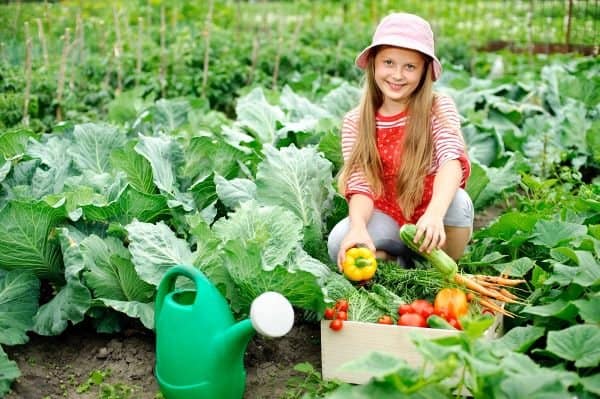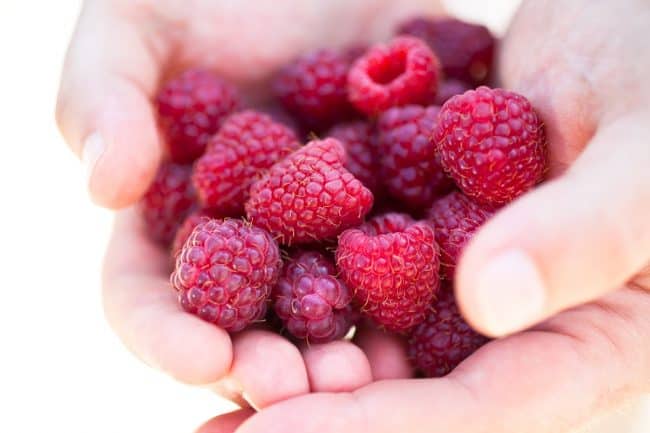Gardening In The Pacific Northwest
It's easy to start vegetable gardening. Well, it can be. Read on for several ideas for getting started in small, easy ways.
Vegetable gardening is a great family activity or for anyone. It's one of the most rewarding home projects you can do. Whether you own or rent a house, or live in a condominium or apartment, you can have a vegetable garden in some form.
You can grow a little or a lot, from a few salad greens and cherry tomatoes, to a large plot for a variety of vegetables from asparagus to zucchini.

Young girl in a vegetable garden – DepositPhotos.com
Tips for fruit and vegetable gardening in the Pacific Northwest
What to grow? You'll get the most reward by planting fruits and vegetables that you and your family already enjoys.
Most fruits and vegetables need at least six hours of direct sunlight a day, and heat-loving plants require more (more on this below). So watch where the sun shines on your chosen garden space and pick the sunniest spots. If you are growing vegetables in containers, you have the ability to move them throughout the day to follow the sun.
Some plants, such as as berries and many herbs only need to be planted once and will grow continually. These plants are called perennials. Many other popular vegetables are annuals that need to be newly planted each year.
The spring planting season in the Northwest begins in February and goes until June. Exactly when to plant depends on the type and variety of fruits and vegetables you are growing. So, follow the instructions on the seed packet or do a little research on gardening sites (we offer some links below) and mark planting dates on your calendar for each variety.
Seeds or starts? Most vegetables can be grown from seed. But for heat-loving plants, you'll have more success if you buy starts or small plants from a nursery. Either way, choose varieties that are stated to grow well in the cool Pacific Northwest marine climate.
- Vegetables that grow easily from seed include beans, garlic, greens of any type, onions, peas, radishes, and root vegetables (beets, carrots, and turnips). Radishes are good, too–they grow fast and add pleasing crunch and zest to salads.
- Vegetables that are best grown from starts include heat-loving such as cucumbers, eggplant, tomatoes, peppers, and melons. For these vegetables, smaller varieties generally do better. For example, lemon or Persian cucumbers, Asian or Thai eggplants, cherry tomatoes, hot peppers.
More information about vegetable gardening in the Pacific Northwest:
- Tilth Alliance
- WSU Extension Gardening Tip Sheets
- WSU Extension Home Vegetable Gardening in Washington
- King County Master Gardener Demonstration Gardens
- Rainy Side Gardeners
- Urban Farm Hub
Love our cheap ideas? Get our FREE email newsletters.
Choose from daily, weekly, and monthly lists:
Click here to subscribe
Urban vegetable gardens
There are several easy ways to start small: a salad garden, container gardening, raised beds and "square foot" gardening, parking strips, landscape gardening, or join a community garden and share the work with others.
Salad gardens
Salad greens are some of the easiest vegetables to grow. They grow best in cooler weather in spring and fall. If you plant new seeds every two to four weeks, you can have a continuous crop to harvest for salads and soups all season long.
Grow a variety of greens to use fresh in salads, as well as hearty greens for soups and sides. Here are some ideas:
- Greens for fresh salads and slaws include arugula, cabbages, chard, chicory, cress, endive, escarole, lettuces, mizuna, and spinach.
- Greens for soups and sides include bok choy, broccoli raab, cabbage, chard, collards, kale, mustard greens, and spinach.
You can grow greens anywhere vegetables will grow: in containers, raised beds, a parking strip, in the landscape, or in a vegetable plot.
Container vegetable gardens
Container gardening is a great choice if you live in an apartment or condominium. Choose flower pots or other containers that are at least 12-inches wide, long, and tall–this is the minimum to grow most types of edibles or a few herb starts.
You can use any larger container such as a wooden half-barrel, 5-gallon bucket, a metal wash tub or trough—or any container that holds soil and has drainage holes (or you can punch holes in the bottom).
I've also used a large tub with no holes on a wood deck–in this cased, added a layer of pea gravel in the bottom, then used several smaller pots with drainage holes. You don't want pots standing in water, so this setup allows it to drain through into the gravel.
- Some good choices for container gardens include tomatoes, salad greens, beans, berries, and herbs.
- Note: each 12-inch pot filled with potting soil and a vegetable start, herb plant, or seeds will cost around $10.
Raised beds and Square Foot Gardening
You can think of raised beds as giant container gardening. Simply put, you construct a big box and fill with soil.
Raised bed gardens are easier than digging a garden plot in your yard. So they're quick to start, easy to care for, and expandable by adding more boxes. Because you need to add good growing mix, it can be a bit pricey the first year. But after that, you just need seeds and plants and some soil amendment each year.
Materials for the box can be made from purchased, re-purposed, or recycled wood, metal, large stones, bricks, cement blocks, plastic panels, etc. Pretty much any material that can form a box and hold soil.
- A "container" can also be created from rolled up burlap coffee bags. Simply spread growing mix to a depth of 12-inches on any area of ground, then roll up the burlap bags and place around the edges to contain the soil. For an urban example, drive by the kitchen garden on First Hill in Seattle at the southeast corner of Madison St. and Terry Ave. (from the freeway, head east on Madison–the garden is just on your right after Terry Ave.). The garden is a ministry of St. James Cathedral–the food grown is used in their community kitchen to provide fresh produce for the 150 hot meals a day prepared for those in need.
Square Foot Gardening is a special raised bed method that uses a 4' X 4' box, a special soil mix, and a grid planting system. This method tends to produce high yields in very little space. The soil mix can easily be made at home. The planting grid can be any material, such as wood or vinyl strips, twine, or PVC pipe.
Note: a 4′ X 4′ box filled with potting soil and 12 varieties of vegetables (seeds or starts) will cost in the range of $120-$150.
For more information, visit:
- Favorite Raised Bed Designs from Sunset Magazine
- Square Foot Gardening Foundation
Parking strip vegetable gardens
Parking strips between the sidewalk and street can be turned into a vegetable garden. However, they are not always a good place to grow food.
- Read the Seattle Department of Transportation guide for Growing Food in Planting Strips.
Landscape vegetable gardens
Rather than find containers, build boxes, or dig up an area of the yard, you can simply add a few vegetables and fruits to your landscape. Tuck in bush beans, cucumber or tomatoes, blueberry bushes, strawberry plants, herbs, and other edibles among your landscape plants.
Some fruits that grow well in the Pacific Northwest include grape and kiwi vines; apple, plum, and pear trees; blueberry bushes; and raspberry canes. Berries or raspberries make a great hedge. Fruits that grow on vines and dwarf fruit trees can also be good choices for smaller urban gardens.
Take advantage of a wall or fence, especially one that faces south (where the sun is strongest). Add a trellis for climbing plants, such as tomatoes, peppers, peas, or pole beans. Vines and dwarf fruit trees can also be tied to a trellis and allowed to spread against a south facing wall.
Community gardens
There are a number of organizations doing community gardening, where the work and produce is shared.
Seattle Alleycat Acres connects people, place, and food by transforming underutilized urban spaces into neighborhood run farms. They work closely with Seattle Department of Transportation, Seattle Parks and Recreation, and Seattle Department of Neighborhood P-patch, as well as numerous food banks and service providers to grow and distribute thousands of pounds of free organic produce every year. During the growing season (March-October) each farm hosts weekly open hours for you to come meet your neighbors, pick some veggies, and get dirty! Come as you are, no experience or equipment necessary!
Seattle P-Patch Community Gardening Program. The name P-Patch comes from the program's first community garden, which started in 1973 at Picardo Farm in north Seattle. So, the 'P' in P-Patch stands for a big thank you to the Picardo family. Today, there are P-Patch community gardens found in nearly every neighborhood throughout Seattle. P-Patches come in many shapes, sizes, and ownerships.With the huge and growing interest in gardening and urban agriculture, all p-patches have a waiting list . So if you are at all interested, get on the waiting list as soon as possible.
Seattle City Fruit works neighborhood by neighborhood to help residential fruit tree owners grow healthy fruit to harvest and use what they can and to share what they don't need.
Seattle Beacon Food Forest is an edible urban forest garden on Seattle's Beacon Hill that inspires the community to gather together, grow its own food, and rehabilitate our local ecosystem.
Seattle UW Farm is a student-powered urban farm & educational facility located on the University of Washington's Seattle Campus. Their mission is to be the campus center for the practice and study of urban agriculture and sustainability, as well as an educational, community-oriented resource for people who want to learn about building productive and sustainable urban landscapes.
Gardening Classes
Find gardening classes:
- Gardening classes with Tilth Alliance
- Master Gardeners of King County "Growing Groceries" series
- Edible Gardens Workshop Series with the Pierce Conservation District, WA
But wait, there's more!
- Find home gardening resources and plant sales.
- Where to order vegetable and herb seeds online
- Nurseries & garden centers in the Puget Sound region
- Home & Garden shows in the Puget Sound region.
- And here's a list of 101+ always free things to do for fun.
- More free and cheap things to do every day: Greater Seattle on the Cheap event calendar.
- Still more ideas for frugal fun: Greater Seattle on the Cheap home page.
Love our cheap ideas? Get our FREE email newsletters. Choose from daily, weekly, and monthly lists. Click here to subscribe.
Upcoming Garden Tours & Gardening Classes
(If nothing is listed below, there are no upcoming garden tours in the next 90 days.)
Wednesday, November 17, 2021
Wednesday, December 1, 2021
Wednesday, December 8, 2021

Nothing says summer like a handful of fresh red raspberries – DepositPhotos.com
Gardening In The Pacific Northwest
Source: https://www.greaterseattleonthecheap.com/vegetable-gardening-pacific-northwest/
Posted by: partainovertutremew.blogspot.com

0 Response to "Gardening In The Pacific Northwest"
Post a Comment